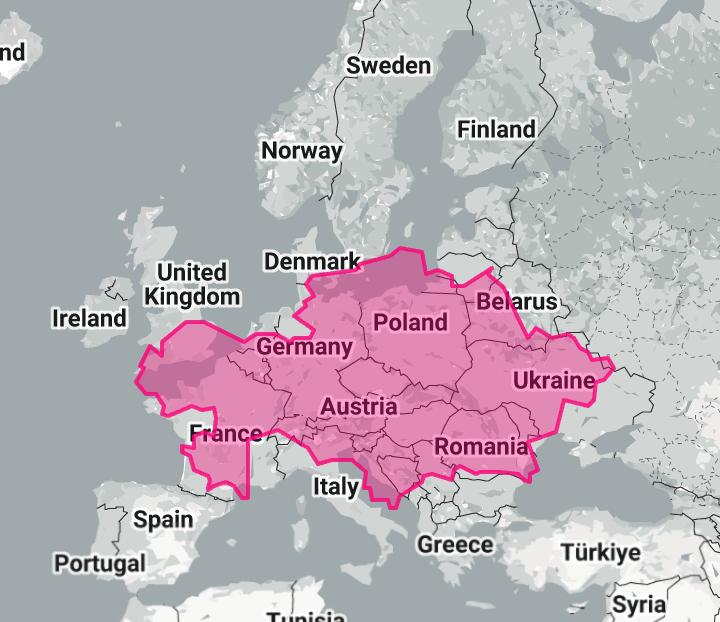Kazakhstan Size Compared to Europe Map


Alex Cartwright
Senior Cartographer & GIS Specialist
Alex Cartwright is a renowned cartographer and geographic information systems specialist with over 15 years of experience in spatial analysis and data...
Geographic Analysis
What This Map Shows
The "Size of Kazakhstan Compared to Europe" map provides a striking visual comparison of Kazakhstan's vast land area against the backdrop of Europe. Kazakhstan, the largest landlocked country in the world and the ninth largest overall, spans an impressive 2.7 million square kilometers. In contrast, Europe, with its diverse landscapes and nations, occupies a total area of about 10.18 million square kilometers. By placing these two regions side by side on a map, we can immediately grasp the sheer scale of Kazakhstan and the significant geographical differences between it and the European continent.
Deep Dive into Kazakhstan's Size and Geography
Kazakhstan’s geographical size is not just a number; it tells a story of varied landscapes, climates, and ecosystems. Encompassing steppes, mountains, deserts, and lakes, the country is a geographical mosaic that plays a crucial role in Central Asia. The Caspian Sea, the world’s largest inland body of water, lies to the west, while the Altai Mountains rise in the northeast. With a length of about 3,000 kilometers from west to east and around 1,600 kilometers from north to south, Kazakhstan offers a diverse array of natural environments.
Interestingly, the country is situated at a crossroads of Europe and Asia, which influences not only its geography but also its cultural and historical contexts. The northern part of Kazakhstan is predominantly flat steppes, while the southern regions feature mountainous terrain and desert landscapes. Have you ever wondered how this diversity affects the climate? Kazakhstan experiences a continental climate, characterized by hot summers and cold winters, which can vary significantly across its vast expanse.
In terms of population density, Kazakhstan is relatively sparsely populated. With a population of around 19 million, the country has a population density of approximately 6.5 people per square kilometer. This contrasts sharply with many European countries, where urbanization leads to much higher densities. The capital city, Nur-Sultan (formerly Astana), is located in the north-central part of the country and serves as a political and administrative hub amidst the wide-open spaces.
Kazakhstan's size also has significant geopolitical implications. It borders Russia to the north, China to the east, and several Central Asian countries, including Kyrgyzstan, Uzbekistan, and Turkmenistan. This location makes it a pivotal player in regional trade and energy transit routes, connecting Asia and Europe.
Regional Analysis
When comparing Kazakhstan to Europe, it’s essential to break down the geographical characteristics regionally. In Europe, countries like Germany and France are densely populated with urban centers that drive economic activity. In contrast, Kazakhstan's population is unevenly distributed, with most people living in the northern regions. The cities of Almaty and Nur-Sultan are significant urban centers, yet much of the country remains rural and underdeveloped.
Moreover, the environmental challenges faced by Kazakhstan, including desertification in the south and pollution from industrial activities, highlight stark contrasts with European nations that have more stringent environmental protections. For example, the Aral Sea, once one of the largest lakes in the world, has drastically shrunk due to irrigation projects and is now a symbol of environmental degradation, while many European countries have made strides toward sustainable water management.
Significance and Impact
Understanding the geographical size of Kazakhstan in relation to Europe is crucial for several reasons. Firstly, it emphasizes the need for effective resource management and environmental sustainability in a country that is rich in natural resources, including oil and gas. As global energy demands evolve, Kazakhstan’s geographical position makes it a key player in energy security and trade routes, especially as Europe seeks to diversify its energy sources.
Furthermore, the map serves as a reminder of the geopolitical dynamics in Central Asia. With rising tensions and shifting alliances, Kazakhstan’s vast landscape and strategic location will undoubtedly influence regional stability and economic development. Current trends indicate a growing focus on infrastructure development, including the Belt and Road Initiative, which seeks to enhance connectivity between Asia and Europe.
In conclusion, the "Size of Kazakhstan Compared to Europe" map is not just a tool for comparison; it opens up discussions about geography's role in shaping cultures, economies, and environmental policies. As we look to the future, understanding these geographical contexts will be vital for both Kazakhstan and Europe as they navigate the complexities of a rapidly changing world.
Visualization Details
- Published
- October 26, 2025
- Views
- 6
Comments
Loading comments...